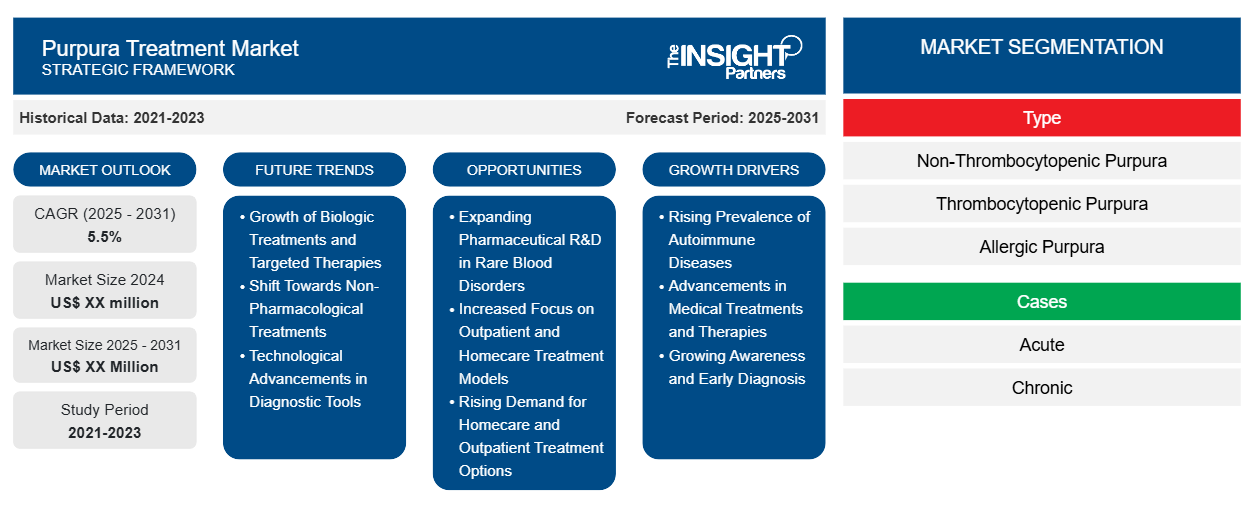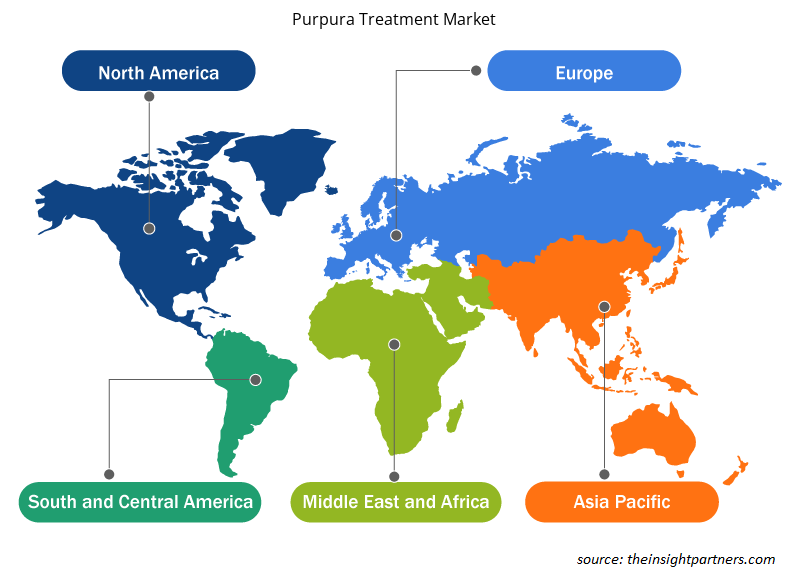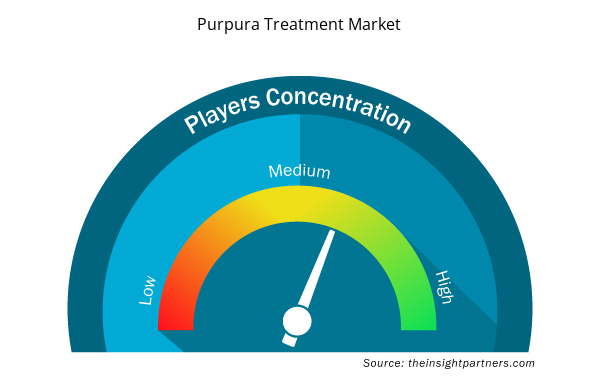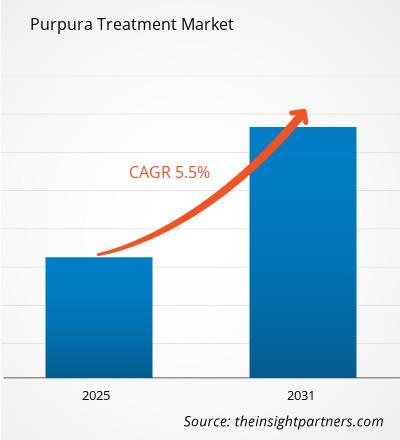The Purpura Treatment Market is expected to register a CAGR of 5.5% from 2025 to 2031, with a market size expanding from US$ XX million in 2024 to US$ XX Million by 2031.
The report is segmented by Type (Non-Thrombocytopenic Purpura, Thrombocytopenic Purpura, Allergic Purpura); Cases (Acute, Chronic); and Treatment (Corticosteroids, Intravenous Immunoglobulin, Other Drug Therapies). The global analysis is broken down at the regional level and for major countries. The market evaluation is presented in US$ for the above segmental analysis.
Purpose of the Report
The report Purpura Treatment Market by The Insight Partners aims to describe the present landscape and future growth, top driving factors, challenges, and opportunities. This will provide insights to various business stakeholders, such as:
- Technology Providers/Manufacturers: To understand the evolving market dynamics and know the potential growth opportunities, enabling them to make informed strategic decisions.
- Investors: To conduct a comprehensive trend analysis regarding the market growth rate, market financial projections, and opportunities that exist across the value chain.
- Regulatory bodies: To regulate policies and police activities in the market with the aim of minimizing abuse, preserving investor trust and confidence, and upholding the integrity and stability of the market.
Purpura Treatment Market Segmentation
Type
- Non-Thrombocytopenic Purpura
- Thrombocytopenic Purpura
- Allergic Purpura
Cases
- Acute
- Chronic
Treatment
- Corticosteroids
- Intravenous Immunoglobulin
- Other Drug Therapies
Customize This Report To Suit Your Requirement
You will get customization on any report - free of charge - including parts of this report, or country-level analysis, Excel Data pack, as well as avail great offers and discounts for start-ups & universities
Purpura Treatment Market: Strategic Insights

- Get Top Key Market Trends of this report.This FREE sample will include data analysis, ranging from market trends to estimates and forecasts.
Purpura Treatment Market Growth Drivers
- Rising Prevalence of Autoimmune Diseases: The treatment market for purpura is growing because the number of autoimmune diseases continues to rise. The skin condition purpura which shows purple spots or patches from subcutaneous bleeding typically accompanies autoimmune diseases such as idiopathic thrombocytopenic purpura (ITP), systemic lupus erythematosus (SLE), and vasculitis. Autoimmune diseases happen when the immune system wrongly attacks healthy body tissues which results in inflammation and damage to blood vessels. The global increase of autoimmune diseases cases raises demand for successful purpura treatments. In autoimmune diseases including ITP the immune system attacks platelets which results in decreased platelet count that makes patients prone to bleeding conditions such as purpura. The rise in autoimmune disease prevalence leads to more people needing purpura treatments. Increased awareness about autoimmune diseases combined with advanced diagnostic tools and higher healthcare spending in regions with high diagnosis rates is driving the market. The frequency of purpura and related disorders will likely increase because aging populations along with lifestyle elements such as stress and obesity and environmental conditions heighten autoimmune disease risks. Healthcare providers along with pharmaceutical companies focus their efforts on creating targeted therapies for these conditions which leads to expansion in the purpura treatment market.
- Advancements in Medical Treatments and Therapies: The purpura treatment market is expanding because of medical treatments and therapies advancements. Current drug therapies like corticosteroids along with immunosuppressive agents and thrombopoietin receptor agonists show effectiveness in purpura treatment particularly for conditions such as ITP. Therapies which restore immune system balance while boosting platelet levels lead to better patient results and lessen purpura symptom intensity. Monoclonal antibodies and gene therapy represent recent biologic treatment innovations that can more effectively target autoimmune-related purpura's root causes. Personalized medicine is becoming essential in purpura treatment because medical interventions are now customized based on each patient’s genetic profile and specific disease attributes. The development of new diagnostic instruments like sophisticated blood tests together with imaging technology advancements has enhanced early detection capabilities and treatment management for purpura patients. The purpura treatment market looks set for growth as these innovations develop further. Healthcare providers can now give patients more specific treatments that are less invasive which leads to quicker recovery times and fewer recurring symptoms. The market growth is increasing because patients accept non-invasive treatments and drugs that produce fewer side effects which leads to better compliance. The advancement of research into new treatment mechanisms will lead to the creation of emerging therapies which offer substantial opportunities for both pharmaceutical companies and researchers working on purpura treatments.
- Growing Awareness and Early Diagnosis: Market growth is propelled by increasing understanding of purpura along with its root causes. Purpura often manifests not as an independent condition but as a symptom indicating deeper health problems like bleeding disorders or autoimmune diseases. Patients now seek medical help sooner because the public understands purpura’s connection to diseases such as ITP and vasculitis. Identifying purpura early enables more successful treatments which lead to improved patient recovery results. Specialized clinics and trained healthcare professionals who focus on rare disease diagnostics now allow faster and more precise detection of purpura. Advanced diagnostic tests including platelet count assessments bone marrow tests and blood coagulation studies enable doctors to determine the underlying cause of purpura symptoms. Healthcare organizations and governmental bodies conduct educational campaigns to teach medical providers and the general public how to identify purpura as an indicator of a more severe health problem. Healthcare providers now emphasize early intervention and treatment options which leads to better patient outcomes while minimizing complications. As awareness about purpura grows so will the need for specialized treatments which will expand the market for purpura therapy as diagnoses increase.
Purpura Treatment Market Future Trends
- Growth of Biologic Treatments and Targeted Therapies: The purpura treatment market now sees biologic treatments and targeted therapies as rapidly developing top trends. Traditional treatments such as corticosteroids and immunosuppressive drugs present substantial side effects and show limited effectiveness in some patients which makes biologic treatments preferable for targeted purpura treatment. The use of monoclonal antibodies like rituximab targets immune system reactions responsible for platelet destruction in ITP patients to enhance treatment results. Thrombopoietin receptor agonists like eltrombopag promote increased platelet production and show growing use as treatments for chronic ITP among other disorders related to platelet function. Biologic treatments deliver precise purpura management while avoiding the extensive immunosuppression seen with conventional medication. The development of biologic treatments will accelerate as scientists learn more about autoimmune disease mechanisms and platelet production which will create new treatment possibilities in the purpura treatment market. The market growth for biologics will accelerate due to their rising popularity and effectiveness which will become accessible to more patients across the globe.
- Shift Towards Non-Pharmacological Treatments: The purpura treatment market is witnessing an expansion of interest toward non-pharmacological treatment approaches. Many patients with purpura are exploring alternative treatments that can either complement or substitute traditional drug treatments like corticosteroids and thrombopoietin receptor agonists. Researchers are examining non-pharmacological treatments like dietary interventions and physical therapies alongside lifestyle changes as potential effective strategies for purpura symptom management which leads to better patient results. Some dietary supplements such as vitamin K, folate and iron have been found to strengthen platelet function and improve vascular health which can lessen the severity of purpura. Research demonstrates that stress management techniques and physical exercise improve immune function and circulation which could help reduce bleeding episodes in conditions such as ITP. Research into complementary therapies including acupuncture and herbal medicine continues as potential adjuncts to traditional medical treatments. The increasing body of research demonstrating non-pharmacological benefits suggests these methods will become part of treatment plans especially for those patients who find traditional medications ineffective or who seek holistic therapeutic approaches. The move towards non-pharmacological treatments creates business opportunities for companies to develop natural remedies and lifestyle solutions specially designed for purpura patients along with wellness products. Medical professionals expect the purpura treatment market to evolve as more patients seek alternative therapeutic options.
- Technological Advancements in Diagnostic Tools: The purpura treatment market will be transformed by technological advancements in diagnostic tools because they will allow for earlier and more precise diagnoses. Physicians can identify underlying conditions more quickly through detailed information from enhanced blood tests like next-generation sequencing and advanced platelet function assays which evaluate purpura causes. Artificial intelligence (AI) applications that examine imaging scans and lab results are making diagnostic procedures faster and more precise. Artificial intelligence algorithms have the capability to identify slight variations in platelet counts as well as other biomarkers which human observers might miss. Machine learning integration into healthcare software assists doctors in creating individualized treatment plans through disease progression prediction from patient data analysis. Current diagnostic practices benefit from technological innovations as patients receive earlier diagnoses and tailored treatment plans. The purpura treatment market will improve through more effective condition management which will lead to superior patient results and a larger patient population as diagnostic tools keep advancing.
Purpura Treatment Market Opportunities
- Expanding Pharmaceutical R&D in Rare Blood Disorders: Advancements in pharmaceutical research and development (R&D) for rare blood disorders will generate positive outcomes for the purpura treatment market. Purpura typically appears alongside diseases such as ITP which result from immune system malfunction that destroys platelets. The advancement of purpura treatments will become more likely as pharmaceutical companies increase their research efforts on rare blood disorders. Investing in research for orphan drugs that enhance platelet counts and manage immune system function provides promising growth potential. Patients suffering from chronic purpura could receive enduring treatments through the progress of gene therapy alongside regenerative medicine developments. Through targeted therapies and personalized medicine companies aim to address genetic and immunological factors in purpura that may result in breakthrough treatments. Advancements in rare blood disorder research will lead to more effective treatments which will expand the purpura treatment market.
- Increased Focus on Outpatient and Homecare Treatment Models: The purpura treatment market is transitioning toward outpatient and homecare treatment models because growing demand exists for care solutions that are convenient to patients and cost-effective. Patients increasingly choose non-hospital treatment options such as outpatient care and homecare services for purpura instead of hospital-based treatments in recent years. Patients receive medical treatment and monitoring during outpatient care without hospital admission which allows them to maintain their daily schedules more easily. Patients with purpura can receive subcutaneous thrombopoietin receptor agonists along with oral corticosteroids and immunosuppressive agents through outpatient treatment which decreases their hospital visit frequency. More patients today are choosing homecare services which enable them to undergo medical treatment within their own homes. Chronic purpura patients who need routine platelet assessments and treatment modifications find great advantages from this service. Healthcare facilities receive less strain through homecare services that provide blood tests and platelet monitoring along with medication administration which helps patients better manage their conditions. Developments in medical technology including portable monitoring devices together with telemedicine platforms and home infusion services are facilitating the transition to outpatient and homecare treatment models. The easier access and more efficient delivery of these treatment models will boost the purpura treatment market by providing patients with flexibility options that save healthcare costs while enhancing their satisfaction levels.
- Rising Demand for Homecare and Outpatient Treatment Options: The demand for homecare and outpatient treatments for purpura expands because healthcare systems evolve to meet patients' needs for convenience and cost-effectiveness. Hospitalization and long-term care represent common traditional treatment approaches for purpura yet remain both expensive and burdensome for patients. Thanks to progress in medical treatment protocols and devices, more patients with purpura symptoms now choose homecare services for their treatment. Modern medical advances including oral drugs and subcutaneous shots along with portable monitoring devices now enable patients to control their condition from their homes. Companies that produce purpura treatments can expand their product lines because homecare is becoming more popular and patients want more home-based treatment options. Patients now have better access to specialized medical attention for rare blood disorders through outpatient centers which eliminate hospital stays. Businesses that provide homecare and outpatient services are set to achieve larger market shares and higher profits as demand for these treatment options grows.
Purpura Treatment Market Regional Insights
The regional trends and factors influencing the Purpura Treatment Market throughout the forecast period have been thoroughly explained by the analysts at Insight Partners. This section also discusses Purpura Treatment Market segments and geography across North America, Europe, Asia Pacific, Middle East and Africa, and South and Central America.

- Get the Regional Specific Data for Purpura Treatment Market
Purpura Treatment Market Report Scope
| Report Attribute | Details |
|---|---|
| Market size in 2024 | US$ XX million |
| Market Size by 2031 | US$ XX Million |
| Global CAGR (2025 - 2031) | 5.5% |
| Historical Data | 2021-2023 |
| Forecast period | 2025-2031 |
| Segments Covered |
By Type
|
| Regions and Countries Covered | North America
|
| Market leaders and key company profiles |
Purpura Treatment Market Players Density: Understanding Its Impact on Business Dynamics
The Purpura Treatment Market market is growing rapidly, driven by increasing end-user demand due to factors such as evolving consumer preferences, technological advancements, and greater awareness of the product's benefits. As demand rises, businesses are expanding their offerings, innovating to meet consumer needs, and capitalizing on emerging trends, which further fuels market growth.
Market players density refers to the distribution of firms or companies operating within a particular market or industry. It indicates how many competitors (market players) are present in a given market space relative to its size or total market value.
Major Companies operating in the Purpura Treatment Market are:
- Amgen Inc
- Bristol-Myers Squibb Company
- F. Hoffman-La Roche
- GlaxoSmithKline Plc.
- Grifols Biologicals Inc
- Hovione
Disclaimer: The companies listed above are not ranked in any particular order.

- Get the Purpura Treatment Market top key players overview
Key Selling Points
- Comprehensive Coverage: The report comprehensively covers the analysis of products, services, types, and end users of the Purpura Treatment Market, providing a holistic landscape.
- Expert Analysis: The report is compiled based on the in-depth understanding of industry experts and analysts.
- Up-to-date Information: The report assures business relevance due to its coverage of recent information and data trends.
- Customization Options: This report can be customized to cater to specific client requirements and suit the business strategies aptly.
The research report on the Purpura Treatment Market can, therefore, help spearhead the trail of decoding and understanding the industry scenario and growth prospects. Although there can be a few valid concerns, the overall benefits of this report tend to outweigh the disadvantages.
- Historical Analysis (2 Years), Base Year, Forecast (7 Years) with CAGR
- PEST and SWOT Analysis
- Market Size Value / Volume - Global, Regional, Country
- Industry and Competitive Landscape
- Excel Dataset


- Hydrolyzed Collagen Market
- Authentication and Brand Protection Market
- Human Microbiome Market
- Nuclear Decommissioning Services Market
- Nuclear Waste Management System Market
- Flexible Garden Hoses Market
- Small Molecule Drug Discovery Market
- Sexual Wellness Market
- Latent TB Detection Market
- Clinical Trial Supplies Market

Report Coverage
Revenue forecast, Company Analysis, Industry landscape, Growth factors, and Trends

Segment Covered
This text is related
to segments covered.

Regional Scope
North America, Europe, Asia Pacific, Middle East & Africa, South & Central America

Country Scope
This text is related
to country scope.
Frequently Asked Questions
The Purpura Treatment Market is estimated to witness a CAGR of 5.5% from 2025 to 2031.
The major factors driving the Purpura Treatment Market are Rising Prevalence of Autoimmune Diseases, Advancements in Medical Treatments and Therapies, and Growing Awareness and Early Diagnosis.
Future trends in the Purpura Treatment Market are Growth of Biologic Treatments and Targeted Therapies, Shift Towards Non-Pharmacological Treatments, and Technological Advancements in Diagnostic Tools.
Some of the players operating in the market are Amgen Inc, Bristol-Myers Squibb Company, F. Hoffman-La Roche, GlaxoSmithKline Plc., Grifols Biologicals Inc, Hovione, Novartis AG, Pfizer Inc., Sanofi, Celltrion Inc.
The report can be delivered in PDF/PPT format; we can also share an excel datasheet based on the request.
Some customization options available based on the request are an additional 3–5 company profiles and a country-specific analysis of 3–5 countries of your choice. Customizations are to be requested/discussed before making final order confirmation# as our team would review the same and check the feasibility.
Trends and growth analysis reports related to Life Sciences : READ MORE..
2. Bristol-Myers Squibb Company
3. F. Hoffman-La Roche
4. GlaxoSmithKline Plc.
5. Grifols Biologicals Inc
6. Hovione
7. Novartis AG
8. Pfizer Inc.
9. Sanofi
10. Celltrion Inc.

 Get Free Sample For
Get Free Sample For